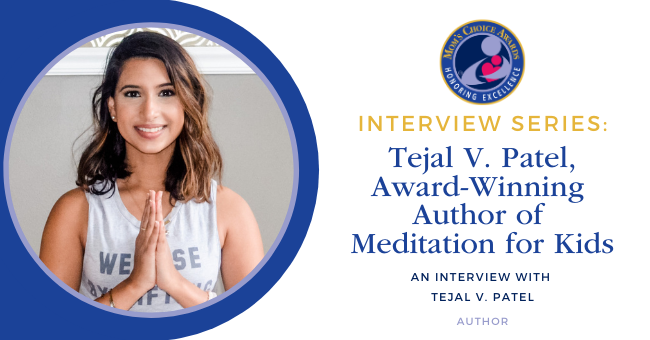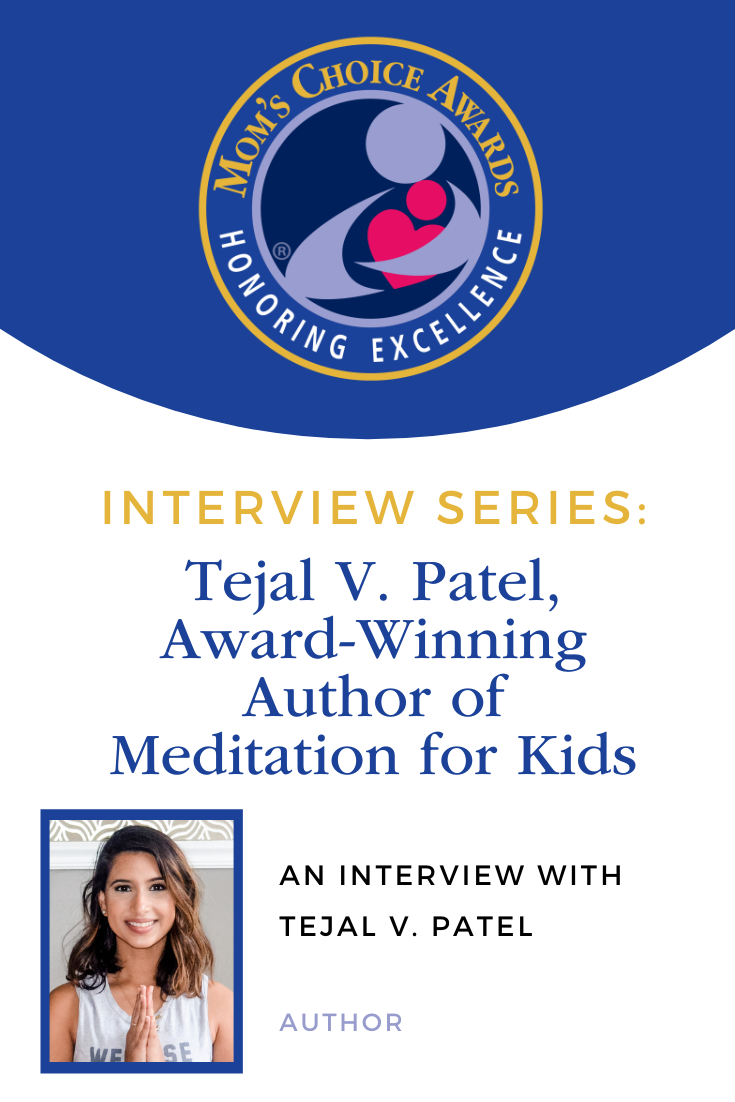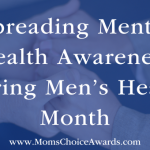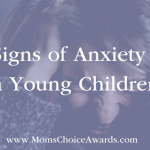Mom’s Choice Awards is excited to announce another post in our interview series where we chat with the inventors, designers, publishers, and others behind some of our favorite family-friendly products.
Hello, Mom’s Choice readers, welcome to another segment of our interview series! For today’s interview, we had the pleasure of speaking with Tejal V. Patel, author of the MCA winning book, Meditation for Kids. Meditation for Kids is a must-have for parents looking to teach their children meditation and mindfulness without having to be an expert themselves. This book is perfect for beginners and experts in meditation alike who are looking to make meditation a fun, family activity while also teaching children how to manage their bodies, energy, emotions, and how they react to stress. Keep reading to find out more about Tejal V. Patel and how she came to write such a helpful and inciteful children’s book!
MCA: Hi Tejal, thank you for giving us this interview, and congratulations on your Mom’s Choice Award! I absolutely loved reading Meditation for Kids. When I think of meditation, I oftentimes think of it as a useful tool for adults only, so seeing a book that shows how to connect meditation with children is a breath of fresh air! With writing such an enlightening book, you must have an extensive background in meditation. Can you tell us a little bit about your background?
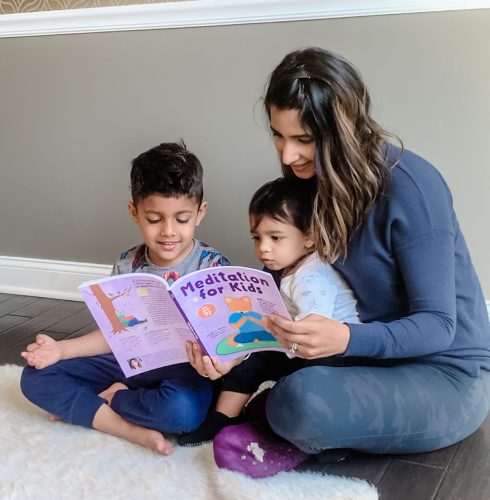
Tejal reading “Meditation for Kids” to her children.
Tejal: I’m a former divorce attorney turned mindful parenting coach and certified mindfulness and meditation expert for families. I’m the host of the Time-In Talks Podcast and author of Mom’s Choice Gold Award-winning book Meditation for Kids:40 Activities to Manage Emotions, Ease Anxiety, and Stay Focused.
I live in South Jersey with my two spirited boys, hubby, and our soulful parakeet Skye. I’m a self-proclaimed learning junkie. I’ve probably read close to 150 personal development books and when I’m not coaching or connecting with moms you’ll find me meditating with my boys.
MCA: What lead you to leave your career as a divorce attorney to becoming an award-winning writer?
Tejal: It’s always been my dream to become a published author and public speaker advocating teaching meditation to kids. I’d been working on writing a book for 2 1/2 years, started pitching my proposal to agents but the Universe had other plans. During this time a publisher reached out to me to write a book on Meditation for Kids because of the growing need and there are only a few niche experts like myself who specialize in teaching young kids Ages 4-8. So my journey to becoming a published author was a divinely orchestrated one. When it was the right time to publish this book, the Universe sought me out. This is just the beginning. I have a few other books that want to be birthed through me that I’m working on.
MCA: If they’re anything like Meditation for Kids then I cannot wait to see the books you have in store for us! Why is it so imperative to teach young kids to meditate?
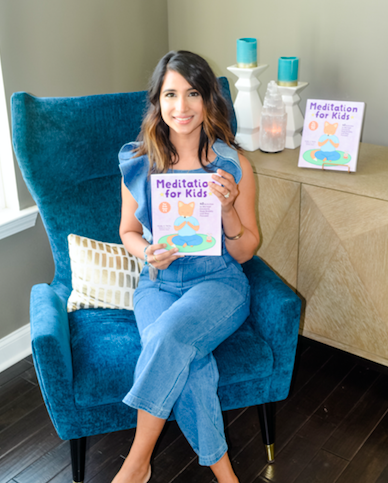
Tejal with her book “Meditation for Kids.”
Tejal: If you ask any parent what they want most for their child, one of the first things they will say “I just want them to be happy.” In this quest to raise happy kids we have to forget that nobody can always be “happy” in life and unpleasant and big feelings like sadness, grief, anger, and disappointment are a natural and normal part of the human experience. And children are experiencing those tough, big emotions at a young age.
According to the National Institute of Mental Health, 1 in 4 children experiences some clinical level of anxiety before they reach adolescence. This statistic was done before the pandemic and many mental health professionals are concerned about what the long-term effects of the pandemic and quarantine will have on children. With children experiencing debilitating stress, anxiety, depression it’s our responsibility as parents, caretakers, and teachers to educate ourselves on how to build stress resilience so we can empower our kids with the tools now instead of having to suffer and wait until they are adults.
What the pandemic has taught us is that life is largely uncertain and out of our control. That unpleasant emotions and situations will arise and life won’t always give you what you want.
I’d much rather raise our future generation of children to know how to handle unhappiness and build their stress resilience to handle any pressure or challenge that comes their way, than raise children who are always happy.
Just like we teach kids the importance of their physical health it’s now essential to prioritize and teach them to take care of their mental health to.
Modern science is catching up to the ancient wisdom of tried and true Yoga and Ayurveda that proves that meditation, mindful breathing and yoga are essential tools to help build stress resilience. I’ve discovered through my 10 years of teaching kids, we can start planting these seeds in kids as young as 2-3.
And children can be taught to do this every day. Just like we expect them to learn at a young age that you brush your teeth to keep sugar bugs away and you wash your body to keep germs away, you can teach them we brush our brain by meditating and taking deep breaths every day to keep yucky thoughts and feelings away. It just requires our patience, time, and consistency. And with the Meditation for Kids book you have a fun and helpful resource to guide you and your child on your path.
It’s important to plant the seeds early because science tells us that between the age of 0-8 everything a child sees, experiences, and hears is planted into their subconscious and becomes part of their conditioning of how they perceive life as they grow up. It behooves us to teach children at a young age when their minds are sponges so that these tools can be used now and throughout their life.
MCA: As early as 2-3, that is so encouraging! How can meditation for kids be taught if they have a hard time focusing and sitting still?
Tejal: How many times have we been told as a child to pay attention or maybe we tell our own child to focus, concentrate, pay attention? We have made this assumption that since we have noticed kids have deep mindful presence and awareness that this is an innate skill, but this is false. Learning to focus on one thing at a time is a struggle for most adults because this is not innate it is a learned skill. We expect kids to focus and sit still but we haven’t given them away to practice this skill. Meditation is how we train our brains and bodies to slow down.
Teaching kids meditation is similar to teaching the ABC’s. We don’t expect our kids to know how to read or write from day one when they learn the ABC’s. This is something we build up to with time and practice.
It’s the same with meditation. We should not expect that our kids will be little buddha baby’s sitting still, quiet, and breathing for 5-10 minutes without interruption. This sort of passive meditation is what we will work up to. When teaching meditation to kids we teach
Science shows that the first language of learning for children is play, stories, and movement. When teaching meditation to kids we introduce a form of active meditation so we can start training kids to learn how to slow down their body, breath, and eventually their minds. We are essentially building our child’s mindfulness muscle to learn how to slow down and focus on one thing at a time.
We start with their eyes open and eventually move to eyes closed. Every breathing exercise in my Meditation for Kids book is linked with a playful movement so there is a mental anchor to help a child stay engaged. If we start laying the foundations of deep breathing, yoga, and meditation by Age 3-4 by Age 8-9 children will be able to sit quietly in meditation for at least 5 minutes.
MCA: That’s astounding and so helpful to know! Does meditation stop meltdowns?
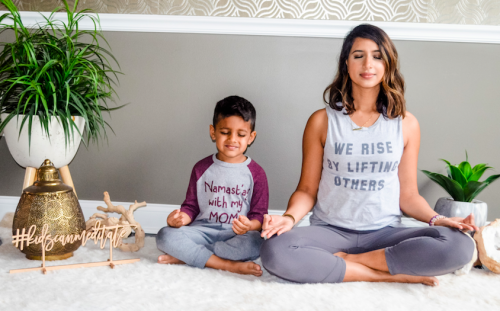
Tejal meditating with her son.
Tejal: Think of it like this. Would you ever tell a child that starting from today there is a new rule? You only have to brush your teeth on the day you eat chocolate. Any other day you don’t have to brush. That would be ridiculous right? We brush daily because it’s daily self-care and it helps protect our teeth against cavities. That’s what meditation is, the daily brushing of our brain. My dad is a dentist and he tells me all the time that brushing alone won’t stop cavities. There are many people who brush daily but still get cavities.
Meltdowns are like cavities. They don’t happen all the time but when they do you can’t just brush your teeth and expect them to go away. You have to go to a skilled dentist who has a specific set of skills and tools to help you find relief. That’s the same thing with a meltdown. When big feelings arise you can meditate them away in the heat of the moment. You can do mindful resets to help you and your child ride through them.
This is how meditation helps with meltdowns. Think of your body like an iPhone. What happens if you don’t charge your phone for 2 days. It dies. It loses its juice and it needs to be recharged. When the battery is in the red zone does your phone work fast and efficiently? No, it stalls, is slow, and doesn’t work as well.
Our body and mind are the most sophisticated technology available. If we don’t charge it up every day we quickly reach meltdown and burnout mode. We start functioning more sluggishly, we react more quickly when things don’t go our way or unexpected things happen in life. Our ability to adapt and resilience reserve gets depleted.
Daily meditation helps charge our battery. This doesn’t stop big feelings to arise it just means you’ll be better prepared to handle meltdowns.
MCA: Daily meditation definitely helps to recharge and reset. Do parents and/or teachers need to practice by themselves before they teach children?
Tejal: It certainly is not a prerequisite for parents and teachers to be experts before teaching kids. That’s why I wrote the Meditation for Kids book and my supplement Meditation for Kids Masterclass course. It helps you feel confident to teach kids without having to become a certified kids meditation teacher.
Many adults have not been taught these skills when we were young and we may be learning for the first time too. When you teach kids, you will learn these tools too. All the tools in the book are rooted in ancient yogic wisdom to help reset our nervous system the right way based on what kind of stress type we are experiencing. If you are anxious vs. angry vs. sad there are different breathing resets and yoga postures that will help your body release the energy of the emotions you are feeling.
MCA: I’ve been seeing rave reviews for Meditation for Kids online. Can you tell us about some of the responses to Meditation for Kids that you’ve experienced?
Tejal: The overwhelmingly powerful response has been so heart-warming.
Parents have been astonished at how quickly their children have been picking up the tools at such a young age. They have noticed their kids better able to communicate their feelings, asking to meditate every day, and creating their own daily habits.
Children have been wanting to share the exercises with their friends, taking it to school and its been a part of many distant learning curriculums where teachers will do a meditation before starting the day.
The best part this has become a deeply bonding family activity where parents spend an intimate moment with their child before bed meditating which parents have found beneficial for them as well.
MCA: That is truly remarkable. Like I said before, I cannot wait to see what you have in store for us next! Thank you for a great interview, Tejal!
You can learn more about Tejal V. Patel and her award-winning book, Meditation for Kids, by visiting her MCA Shop pages.

